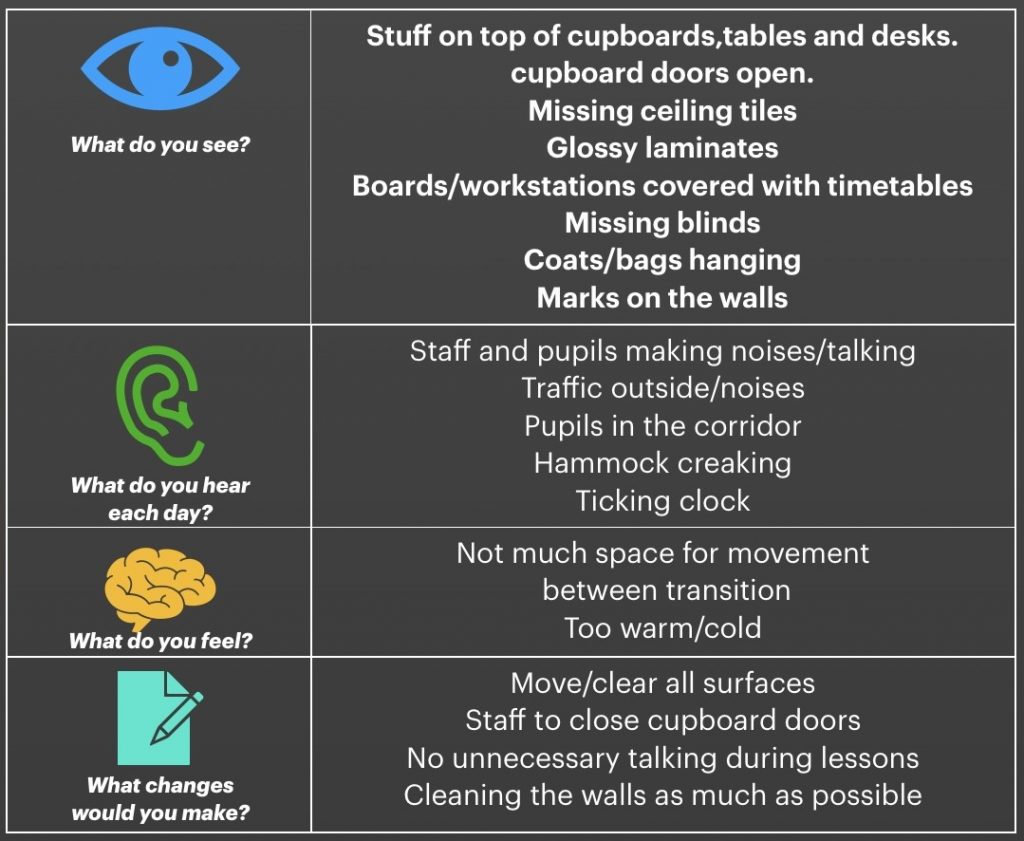Photo by Feliphe Schiarolli on Unsplash
This month I am delighted that Chloe Bingley from New Bridge School in Oldham has agreed to share the work she has being doing with her department looking at their school environment. Chloe provided a simple template for staff to look at their environment and to suggest their own changes. As you will read, the changes were easy to implement and didn’t cost the school any money.
This is an ideal time of year to be critically observing the environment in your setting or home. What changes could you make for the start of the new term in September? Even small changes can make a big difference to individuals with sensory processing differences.
I’ll let Chloe tell you what she did:
Intent
As a department we set out to look at our environment after one of our regular visits from Julia to school. We wanted staff to take responsibility for their own environment and really unpick what changes needed to be made to ensure student spaces were conducive to increased engagement and regulation.
We wanted to create a process which could be easy and simple to complete but have the biggest impact. I created an outline which supported a two-week training package. On the first training session we sent all teachers the Keynote document below , we then sent teachers and their teams off to take an image of their classroom. They were tasked to reflect on what they see, what they hear daily and what they feel when they are sat in their environment. We then asked them to think about and write down the changes they would make to their environments. We then discussed with the team about working on these changes over the following week which allowed students to slowly adjust and enable staff to work on creating the spaces they envisioned from the training.




Implementation
Every team then implemented the changes discussed in the first training session. Each team moved visual distraction from the top of cupboards, removing distracting laminates from walls, reducing clutter within the classroom environments and in some cases rearranged furniture to create a more organised space.
Impact
For the second training session we asked staff to return with an image of the new classroom environment. With this we asked staff to reflect on what they could now see, hear and feel and what changes they may want to make but would be bigger projects. Each team shared and discussed the difference these changes had made and what effect this had on the ability for students to regulate and engage more successfully. Overall, each team noticed an increased improvement.




Alongside this I conducted data on engagement within my class, looking at how students engaged with learning before the changes and after. This was worked out using an average time for the whole class.
The data showed that the week before the changes were made there was 40% engagement for 0-15 minutes, 30% engagement for 20-30 minutes and 30% engagement for 30-40 minutes.
Since we made the environment changes in my class, we conducted data over the week that followed and the data shows that there was 10% engagement for 0-15 minutes, 30% engagement for 20-30 minutes and 60% engagement for 30-40 minutes.
This has had a huge impact on the attainment and progress for pupils and we have seen an increase in student regulation and therefore a calmer and more organised space for students to engage.
Chloe Bingley, Classteacher, New Bridge School, Oldham



